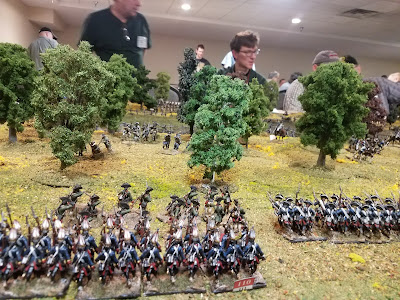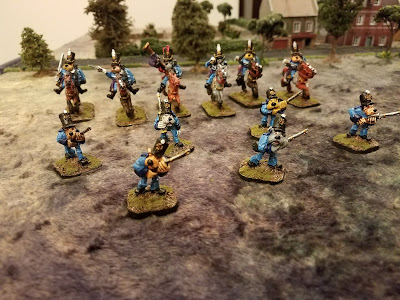After meeting up and getting my dad registered, we did a quick passthrough of the dealer area and the morning flea market session. The only real noteworthy bit was that Chris and I stopped by the booth of The Wargaming Company. I had seen the company and its uniformed penguin logo at previous shows, but had never really explored their offerings before. The company's man product is a Napoleonic rules set titled Es Sans Résultat (or ESR, for short) and as I was really keen to start a large battle Napoleonic project, and the internet, surprisingly, did not have much to say about the current edition, I wanted to see what we could discover. On top of that, I had heard that they were no offering starter sets complete with 10mm figures, bases, and flags for the French, Austrian, and late-war Russian armies - a definite enticement to start a new project. Chris and I wound up spending about an hour with the proprietor and rules writer, David Esteness, who went over the basic concepts and ran through a game turn for us. In my experience with big battle Napoleonic games, anything more than a small subsection of a battle requires a huge table and/or the game bogs down to quickly because the player has too much to worry about at too many different levels of command - in a way, the game can have the player wearing the hats of the corps, division, and brigade commander simultaneously. Our initial impression of ESR was that it doesn't do this. It clearly places the player in the role of the commander of a small army or corps. He/she must provide orders for subordinate division (or sometimes independent brigade) commanders, but do not have to worry too much about how those orders are carried out - as David put it, "You hired people to do that for you." At this point, the composition of the formation and its level of fatigue help determine the results of comment. If things go bad, each formation has its own reformation area to which fleeing units retreat to hopefully be rallied for further fighting instead of immediately heading for the hills. We watched intently as David played out a few rounds of combat for us and were impressed enough by the mechanics that I was seriously considering buying the rules and some starter boxes.
We hung around the vendor area a bit longer, but then headed for our game at 11:00. My dad isn't much of a gamer, having only played a handful of participation games at the dozens of conventions we've been to together. One rules system that particularly stood out for him was the computer-driven Carnage & Glory (he likes not having to worry about a lot of tables and dice). He played an American Civil War game with it at a show years ago (I was probably off fighting some obscure Napoleonic battle) and liked it, so I figured we'd look for a game at the show. When I saw that noted GM (and author) David Bonk was running one of his American War of Independence games, in 40mm no less, I was sold!
The scenario had been advertised as the fighting at Chadds Ford during the battle of Brandywine, but upon arrival we were told we'd be refighting the 1777 Battle of Short Hills. Chris, my dad, and myself found ourselves on the British side, along with two other gamers. One requested the command of our Hessian brigade, Chris took Grant's brigade of British regulars, while we gave my dad the smallest command - the infantry and cavalry of the Queen's Rangers. The remaining brigade was a massive one, including a small group of dismounted light dragoons, two big battalions of light infantry, two of grenadiers, two of Foot Guards, and an artillery battery. I suggested splitting it with the other game - he took command of the combined flank companies, and I had the Guards, dragoons, and guns.
The battlefield consisted of two parallel ridges with some fenced fields in between and a dirt track running across the center. American skirmishers were deployed across the forward ridge and their main line of resistance was arrayed on the rearward one. We entered the table on the long table edge, but because of the limited space were unable to deploy our whole force until the American skirmishers were driven from the wooded rise.
 |
| The battlefield on our left |
 |
| ...and the right |
 |
| The colorful advance of the Hessian brigade |
The Germans had not made enough space for Chris to deploy his British regulars, but I was able to bring up my units on the right of the flank companies. My dad's rangers and cavalry were ready to enter the field as soon as I moved up to keep the enemy cavalry (positioned across from our right flank) in check.
Our initial plan had been for the Guards and flank companies to advance together on the right of the field, but as my battalions neared the first fence line, I realized that the lights and grenadiers were lacking in aggression this day, and that my men would have to take matters into their own hands (** I should note that my dragoons - numbering only a few dozen - were only allowed to deploy dismounted and could not deploy in open order...both of which seemed very odd considering historical practices...and would not be much of a threat to the solid Continental units, so I kept them behind as a reserve). As the Hessians and flank companies plodded through the woods and across the fields and kept the American right and center occupied, I decided to rush my men across the field and charge the small American batteries and the two smaller state line units guarding them. To cover my right flank from the lurking Yankee cavalry, I ask my dad to deploy the Queen's Rangers cavalry and have them attack the enemy horsemen, while his massive infantry battalion could serve as my reserve. The nimble horseman rode onto the table and quickly moved up in parallel with my infantry.
 |
| My battalions (masquerading as the Volunteers of Ireland and fusiliers) advance |
 |
| The troops of the Frantz boys surge forward |
When my dad's dragoons charged the enemy horsemen, the Americans opted to countercharge and the two forces clashed sabers across a fence line. The computer did its calculations and determined the Loyalist horse got the better of the foe and sent the Americans packing. This same turn, I had my guardsmen go in toward the enemy guns, as the real-life Guards officer General Charles O'Hara once claimed, "with zeal and with bayonets only." Unfortunately the enemy generals had not positioned their supporting infantry in a way where they could engage in the melee or fire into the oncoming infantry (their line of sight was blocked by the artillery itself). My Guards, who had suffered very little in their advance, carried the position without difficulty, captured the guns and dispersed the crews. Things were going well on the right flank!
 |
| The Queen's Rangers cavalry and Foot Guards charge the Americans lines |
 |
| The green-clad troopers rush forward to their next melee |
 |
| After clearing the enemy guns, the Guards advance towards their next targets; Queen's Rangers infantry arrives in support |
Sunday saw me return to the show solo (since Chris, like my wife, is a pastor). For the second show in a row, I took advantage of the free tables in the Sunday morning flea market and was able to sell a bunch of hobby-related stuff that had just been collecting dust around my house. Armed with some extra cash, I went back to the vendor hall and picked up some basing accessories, and the ESR rulebook, 1812 campaign guide, and some starter boxes and formation boxes to get working on the French and Russian Napoleonic armies...but more on that later
All and all, another fun convention!





























